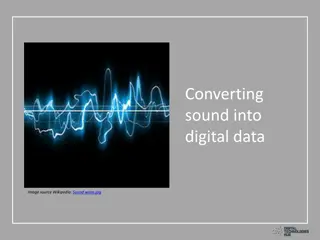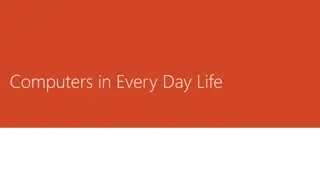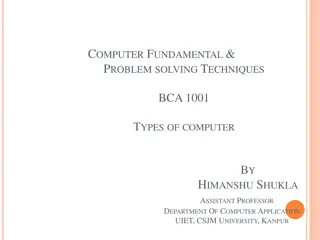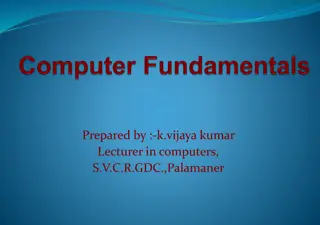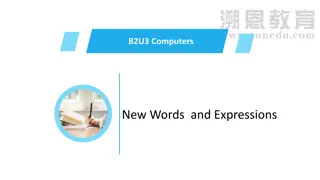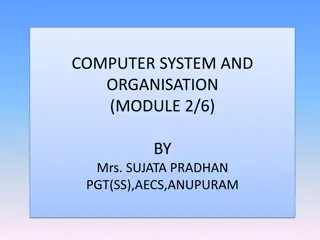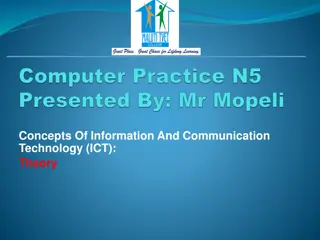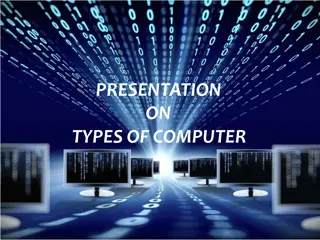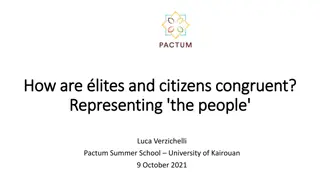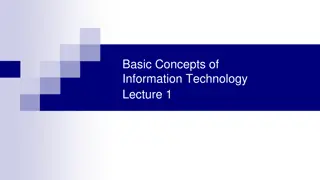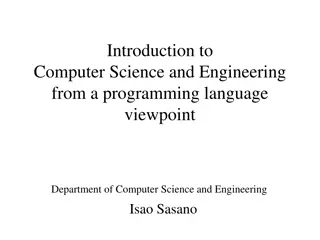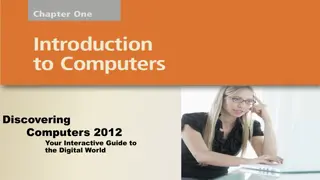Digital Computers and Information Representation Fundamentals
Explore the basics of digital systems, number systems, arithmetic operations, and information representation in computers. Dive into binary, octal, and hexadecimal systems, along with signal processing and number system examples. Gain insights into computer organization and assembly language, utilizing resources like "The Essentials of Computer Organization and Architecture."
Download Presentation

Please find below an Image/Link to download the presentation.
The content on the website is provided AS IS for your information and personal use only. It may not be sold, licensed, or shared on other websites without obtaining consent from the author.If you encounter any issues during the download, it is possible that the publisher has removed the file from their server.
You are allowed to download the files provided on this website for personal or commercial use, subject to the condition that they are used lawfully. All files are the property of their respective owners.
The content on the website is provided AS IS for your information and personal use only. It may not be sold, licensed, or shared on other websites without obtaining consent from the author.
E N D
Presentation Transcript
Logic and Computer Design Fundamentals Chapter 1 Digital Computers and Information
Overview Digital Systems and Computer Systems Information Representation Number Systems [binary, octal and hexadecimal] Arithmetic Operations Base Conversion Chapter 1 2
Course description Course name COMP 3508 - Computer organization and Assembly language Course level Level 5 Equivalent to 3 CH (Credit Hours)
Course description Reference Book The Essentials of Computer Organization and Architecture, 3rd edition Author: Linda Null and Julia Lobur.
Digital System Takes a set of discrete information inputs and discrete internal information (system state) and generates a set of discrete information outputs. Discrete Information Processing System Discrete Inputs Discrete Outputs System State Chapter 1 5
Signal An information variable represented by physical quantity. For digital systems, the variable takes on discrete values. Two level, or binary values are the most prevalent values in digital systems. Binary values are represented abstractly by: digits 0 and 1 words (symbols) False (F) and True (T) words (symbols) Low (L) and High (H) and words On and Off. Binary values are represented by values or ranges of values of physical quantities Chapter 1 6
Number Systems Representation Positive radix, positional number systems A number with radixr is represented by a string of digits: An - 1An - 2 A1A0 . A- 1 A- 2 A- m + +1 A- m in which 0 Ai < r and . is the radix point. The string of digits represents the power series: ( (Number)r= i = 0 (Integer Portion) + (Fraction Portion) ) ( + ) j = - 1 i = n - 1 j = - m i j A r A r i j Chapter 1 7
Number Systems Examples General r 0 => r - 1 r0 r1 r2 r3 r4 r5 r -1 r -2 r -3 r -4 r -5 Decimal 10 0 => 9 1 10 100 1000 10,000 100,000 0.1 0.01 0.001 0.0001 0.00001 Binary 2 0 => 1 1 2 4 8 16 32 0.5 0.25 0.125 0.0625 0.03125 Radix (Base) Digits 0 1 2 3 Powers of 4 Radix 5 -1 -2 -3 -4 -5 Chapter 1 8
Special Powers of 2 210 (1024) is Kilo, denoted "K" 220 (1,048,576) is Mega, denoted "M" 230 (1,073, 741,824)is Giga, denoted "G" Chapter 1 9
Positive Powers of 2 Useful for Base Conversion Exponent Value 0 1 2 3 4 5 6 7 8 9 10 Exponent 11 12 13 14 15 16 17 18 19 20 21 Value 2,048 4,096 8,192 16,384 32,768 65,536 131,072 262,144 524,288 1,048,576 2,097,152 1 2 4 8 16 32 64 128 256 512 1024 Chapter 1 10
Converting Binary to Decimal To convert to decimal, use decimal arithmetic to form (digit respective power of 2). Example:Convert 110102to N10: Chapter 1 11
Converting Decimal to Binary Method 1 Subtract the largest power of 2 (see slide 14) that gives a positive remainder and record the power. Repeat, subtracting from the prior remainder and recording the power, until the remainder is zero. Place 1 s in the positions in the binary result corresponding to the powers recorded; in all other positions place 0 s. Example: Convert 62510 toN2 Chapter 1 12
Commonly Occurring Bases Name Binary Octal Decimal Hexadecimal Radix 2 8 10 16 Digits 0,1 0,1,2,3,4,5,6,7 0,1,2,3,4,5,6,7,8,9 0,1,2,3,4,5,6,7,8,9,A,B,C,D,E,F The six letters (in addition to the 10 integers) in hexadecimal represent: Chapter 1 13
Numbers in Different Bases Good idea to memorize! Decimal (Base 10) 00 01 02 03 04 05 06 07 08 09 10 11 12 13 14 15 16 Binary (Base 2) 00000 00001 00010 00011 00100 00101 00110 00111 01000 01001 01010 01011 01100 01101 01110 01111 10000 Octal (Base 8) 00 01 02 03 04 05 06 07 10 11 12 13 14 15 16 17 20 Hexadecimal (Base 16) 00 01 02 03 04 05 06 07 08 09 0A 0B 0C 0D 0E 0F 10 Chapter 1 14
Conversion Between Bases Method 2 To convert from one base to another: 1) Convert the Integer Part 2) Convert the Fraction Part 3) Join the two results with a radix point Chapter 1 15
Conversion Details To Convert the Integral Part: Repeatedly divide the number by the new radix and save the remainders. The digits for the new radix are the remainders in reverse order of their computation. If the new radix is > 10, then convert all remainders > 10 to digits A, B, To Convert the Fractional Part: Repeatedly multiply the fraction by the new radix and save the integer digits that result. The digits for the new radix are the integer digits in order of their computation.If the new radix is > 10, then convert all integers > 10 to digits A, B, Chapter 1 16
Example: Convert 46.687510 To Base 2 Convert 46 to Base 2 Convert 0.6875 to Base 2: Join the results together with the radix point: Chapter 1 17
Additional Issue - Fractional Part Note that in this conversion, the fractional part became 0 as a result of the repeated multiplications. In general, it may take many bits to get this to happen or it may never happen. Example: Convert 0.6510 to N2 0.65 = 0.1010011001001 The fractional part begins repeating every 4 steps yielding repeating 1001 forever! Solution: Specify number of bits to right of radix point and round or truncate to this number. Chapter 1 18
Checking the Conversion To convert back, sum the digits times their respective powers of r. From the prior conversion of 46.687510 1011102 = 1 32 + 0 16 +1 8 +1 4 + 1 2 +0 1 = 32 + 8 + 4 + 2 = 46 0.10112 = 1/2 + 1/8 + 1/16 = 0.5000 + 0.1250 + 0.0625 = 0.6875 Chapter 1 19
Octal (Hexadecimal) to Binary and Back Octal (Hexadecimal) to Binary: Restate the octal (hexadecimal) as three (four) binary digits starting at the radix point and going both ways. Binary to Octal (Hexadecimal): Group the binary digits into three (four) bit groups starting at the radix point and going both ways, padding with zeros as needed in the fractional part. Convert each group of three bits to an octal (hexadecimal) digit. Chapter 1 20
Octal to Hexadecimal via Binary Convert octal to binary. Use groups of four bits and convert as above to hexadecimal digits. Example: Octal to Binary to Hexadecimal 6 3 5 . 1 7 7 8 Why do these conversions work? Chapter 1 21
A Final Conversion Note You can use arithmetic in other bases if you are careful: Example: Convert 1011102 to Base 10 using binary arithmetic: Step 1 101110 / 1010 = 100 r 0110 Step 2 100 / 1010 = 0 r 0100 Converted Digits are 01002 | 01102 or 4 6 10 Chapter 1 22
Binary Numbers and Binary Coding Flexibility of representation Within constraints below, can assign any binary combination (called a code word) to any data as long as data is uniquely encoded. Information Types Numeric Must represent range of data needed Very desirable to represent data such that simple, straightforward computation for common arithmetic operations permitted Tight relation to binary numbers Non-numeric Greater flexibility since arithmetic operations not applied. Not tied to binary numbers Chapter 1 23
Binary Arithmetic Single Bit Addition with Carry Multiple Bit Addition Single Bit Subtraction with Borrow Multiple Bit Subtraction Multiplication BCD Addition Chapter 1 24
Single Bit Binary Addition with Carry Given two binary digits (X,Y), a carry in (Z) we get the following sum (S) and carry (C): Carry in (Z) of 0: Z X + Y + 0 + 1 + 0 + 1 C S 0 0 0 1 0 1 1 0 0 0 0 0 0 1 0 1 Z X + Y + 0 + 1 + 0 + 1 C S 0 1 1 0 1 0 1 1 1 0 1 0 1 1 1 1 Carry in (Z) of 1: Chapter 1 25
Multiple Bit Binary Addition Extending this to two multiple bit examples: Carries Augend 01100 10110 Addend +10001 +10111 Sum Note: The 0 is the default Carry-In to the least significant bit. 0 0 Chapter 1 26
Single Bit Binary Subtraction with Borrow Given two binary digits (X,Y), a borrow in (Z) we get the following difference (S) and borrow (B): Borrow in (Z) of 0: Z X - Y BS 0 0 0 0 0 1 0 1 -0 -1 -0 -1 0 0 0 0 1 1 0 1 Borrow in (Z) of 1: Z X 1 0 1 0 1 1 1 1 - Y BS -0 11 -1 -0 -1 1 1 1 0 0 0 Chapter 1 27
Multiple Bit Binary Subtraction Extending this to two multiple bit examples: Borrows 0 0 Minuend 10110 10110 Subtrahend - 10010 - 10011 Difference Notes: The 0 is a Borrow-In to the least significant bit. If the Subtrahend > the Minuend, interchange and append a to the result. Chapter 1 28



